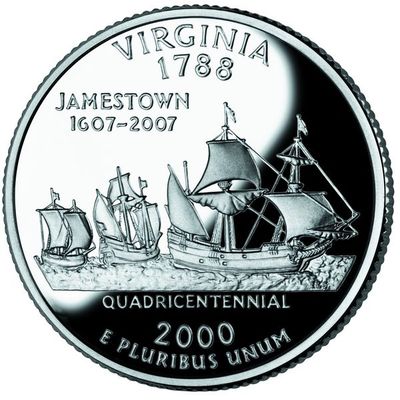
by Meg Marquardt Thursday, January 5, 2012

The 400th anniversary of the founding of the Jamestown settlement is commemorated on the Virginia state quarter. U.S. Mint
Each year, millions of visitors flock to Virginia’s natural wonders, such as Shenandoah National Park, and to historical landmarks, like Jamestown, one of America’s earliest colonies. But a new report by the National Resources Defense Council (NRDC) states that many of Virginia’s landmarks are jeopardized by climate change.
The report, which was also sponsored by the Louisville, Colo.-based Rocky Mountain Climate Organization (RMCO), stated that more than $200 million in tourism dollars and 4,000 jobs in Virginia are at risk due to climate change. For tourism destinations like Jamestown and Chincoteague Island, the main threat is rising sea level: Chincoteague’s famous beaches may disappear as water continues to rise, and Jamestown Island may vanish completely under coastal flooding. In Shenandoah National Park, warmer weather may alter which trees grow in the forests, potentially muting the brilliant fall color changes that draw visitors each year.
“Climate change poses the greatest risk our national parks have ever faced,” said Theo Spencer, senior advocate of the NRDC’s Climate Center, which is headquartered in New York City, in a press release accompanying the report’s publication. (Read the full report here.) “Jamestown, Shenandoah and Chincoteague face greater threats than ever before as a result of climate change, and on a scale that will substantially undercut people’s interest in visiting those historic and natural sites.”
Projected numbers by the U.S. Bureau of Reclamation and several academic institutions suggest there will be a 1-meter rise in sea level by the end of the century. Virginia’s beaches are naturally subsiding, gradually settling to a lower elevation. The combination of lower beaches and higher water will be deadly to local landmarks, especially as stronger hurricanes and coastal storms are also predicted to increase with climate change.
Of particular note in the report is the future of the original Jamestown Fort of 1607. One corner of the fort has already been eaten away by erosion from the James River. But Chincoteague may be the hardest hit: The city sits on a barrier island of the same name, and NRDC reports that the entire island may fragment as the result of constant battering by higher seas and more severe storms.
The report also states that an increase in temperature may cause invasive plants to take over Shenandoah National Park, reducing the vibrancy of the fall colors. By the end of this century, average summer temperatures are predicted to increase by 4.0 degrees Celsius in Jamestown and Chincoteague, and by 4.5 degree Celsius in Shenandoah.
“These three special places deserve particular attention,” said RMCO president Stephen Saunders in the press release. “They show how much Virginia has at stake, from its coasts to its mountains and from its natural and cultural resources to its economy, as people alter the climate.” (Listen to a audio interview with specialists in the field here.)
Though the report specifically details Virginia’s outlook, more states are likely to follow the example to discover how climate change might affect their natural and historical locations — and, in turn, their economies. Be sure to check out Shenandoah’s fall colors this year – you never know what’ll happen next year.
© 2008-2021. All rights reserved. Any copying, redistribution or retransmission of any of the contents of this service without the expressed written permission of the American Geosciences Institute is expressly prohibited. Click here for all copyright requests.